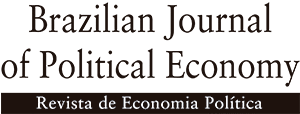RESUMO
Este trabalho tem como objetivo avançar no debate em torno da Lei de Thirlwall Multissetorial, incluindo os fluxos de capitais setoriais e suas implicações para a nova estratégia de crescimento da economia brasileira, que visa estimular as exportações por meio da diversificação dos produtos, da agregação de valor e do aumento da intensidade tecnológica das exportações brasileiras. Para tanto, desenvolve-se um modelo multissetorial com fluxos de capitais setoriais e, na sequência, realizam-se algumas simulações computacionais considerando os principais setores e parceiros econômicos do país (China, Estados Unidos e Bloco Europeu). os resultados sugerem que a melhor estratégia seria estimular os setores específicos, ou seja, ampliar a participação dos setores nos quais o país possua maior vantagem comparativa em relação a cada um dos seus parceiros comerciais (Manufaturados - EUA, Semimanufaturados - Europa, Básicos - China). Não obstante o resultado obtido na simulação, nos moldes do modelo proposto por Hausmann et al. (2004), pode gerar a aceleração do crescimento econômico. Assim, o Plano Nacional de Exportações (2015-2018) deve dar preferência à ampliação de incentivos a setores que apresentem elevadas razões das elasticidades no sentido de Thirlwall.
PALAVRAS-CHAVE:
Lei de Thirlwall Multissetorial; Fluxos de Capitais; Taxa de Câmbio; Crescimento Econômico; Brasil

 Fonte: Elaboração própria.
Fonte: Elaboração própria.
 Fonte: Elaboração própria. A linha cinza representa a taxa mensal de crescimento do PIB simulado. A linha preta representa a taxa de crescimento compatível com a aceleração do crescimento (
Fonte: Elaboração própria. A linha cinza representa a taxa mensal de crescimento do PIB simulado. A linha preta representa a taxa de crescimento compatível com a aceleração do crescimento ( Fonte: Elaboração própria.
Fonte: Elaboração própria.